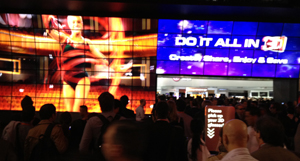Not long before his death Steve Job famously told biographer Walter Isaacson that he had “finally cracked” the problem of television. No one knows quite what he meant, and Apple has shed no light on the subject, but for the sake of the future of TV, let’s hope Steve left something important behind.

At the International Consumer Electronics Show, the overwhelming feeling I got about television is stasis. My colleague Patrick Moorhead has a solid piece on TV makers’ experiments with new user interfaces. But those remain experiments, with no commitment to when, or if, we will see them on TVs you can actually buy. And the user interface, while desperately in need of improvement, is only one piece of a much bigger puzzle.
Related Column: How Sony can beat Samsung and LG on Smart TV Interfaces
The sad truth if you had told me that the TV displays in the Panasonic, Samsung, and Sony booths were actually left over the the 2011 show, I wouldn’t have argued with you. The main difference was much less emphasis on 3D, which the makers now realize is just a feature, not a revolutionary product. Only LG’s booth showed real commitment to 3D, and not necessarily in a good way. Its booth was a jarring riot of gimmicky 3D images coming at you from all sides, an effect allowed by LG’s move to passive, battery-free glasses that don’t need to sync to a particular set. Both LG and Samsung showed 55″ OLED displays, each claiming the world’s largest, but to my eyes OLED remains oversaturated, garish, and a dubious improvement on LED-backlit LCD or plasma.
Even the internet connected TVs, which the makers promoted as this year’s big thing, seemed tired. Basically, they build the capability of a Roku box or other internet-connected device directly into the set. It’s an improvement in convenience, mainly though getting rid of one remote, but hardly enough to send anyone out to buy a new TV.
The fix TV desperately needs is an integrated solution. I want to get all of my TV–the stuff I get over cable as well as the content streamed over the internet in a single box that seamlessly combines all the sources. I don’t much care whether this is built into the set or done in a separate box–the box would have the advantage of allowing ample local storage, while a TV solution would probably have to rely on the cloud to save recorded programs. The difference in convenience is not very significant.
Such a solution would require a new user interface, something much better than Google managed for Google TV. But much more important, and much harder, it requires an entire new business model for content distribution. As I have written many times, the biggest impediment to a this breakthrough is not technology, since the technology needed to make it happen is available today, but breaking the iron triangle of content owners, networks, and cable and satellite distributors who are prospering under the status quo. Can Apple succeed where everyone else has failed? I rather doubt it. But I’m cheering for them anyway.

I agree with being built in or separate box not being an issue. I’ll take one or the other.
For me what needs fixing is two things—dealing with channels and being able to watch what I want when I want. I’ll even concede the “where” and keep it limited to my TV in my den. I see no added benefit to being able to watch my shows in some remote hotel or business room or the loo on a tablet or laptop.
Simplify those two things and my life gets immediately easier. Even with a DVR I have to make sure my programming actually records something new and if the scheduling shifts, because of some news event or sports broadcast, I have accommodated that shift.
That’s the problem I need fixed. Is that what Jobs came up with? Probably not, but I bet his solution makes those issues moot.
Joe
Jobs had to be aware of the iron triangle of content owners, networks, and cable and satellite distributors. When he said “I finally cracked it,” that tells me he found a way to deal with the iron triangle. We’ll know when Apple brings out their TV, but in any case I’m sure it will be well ahead of what anyone else is doing with TV, and I think it’s likely the remote will have a touchscreen.
The magic…
1) IP backbone fast enough to feed HD/3D content to an unlimited number of televisions in the home without a need for any DVR, it’d all be “in the cloud”, and “on demand”.
2) Content that “knows” I want it. TiVo model is good, but could be greatly enhanced to learn my preferences and make good recommendations.
3) Voice recognition… “What’s on TV tonight, and make sure you remind me to watch the debate at 8PM.”
And NO I don’t want to interact with my TV other than setting my watching preferences… OK an occasional voting for my favorite Idol by “clicking” would be OK 🙂
very satisfying in terms of information thank you very much.
Superb post however I was wanting to know if you could write a litte more on this topic? I’d be very grateful if you could elaborate a little bit more.
I really like reading through a post that can make men and women think. Also thank you for allowing me to comment!